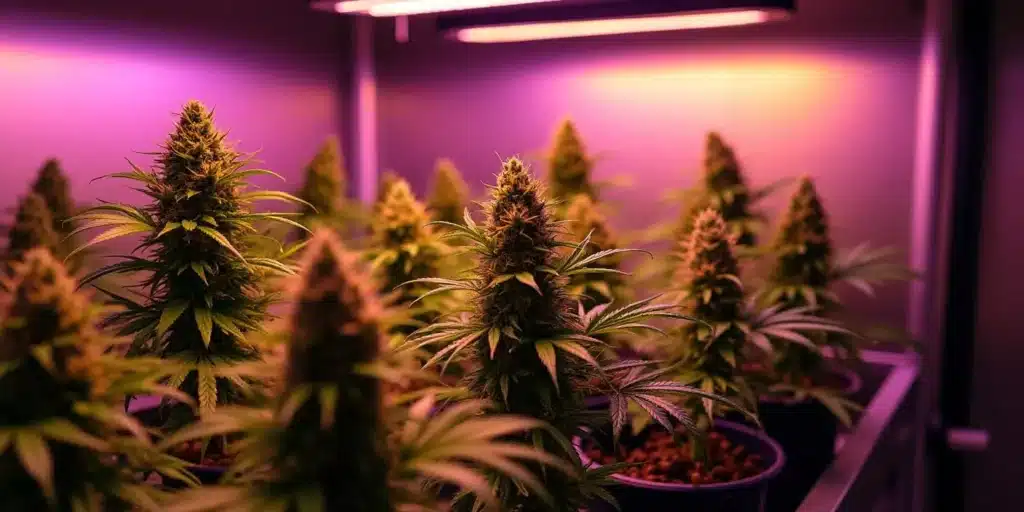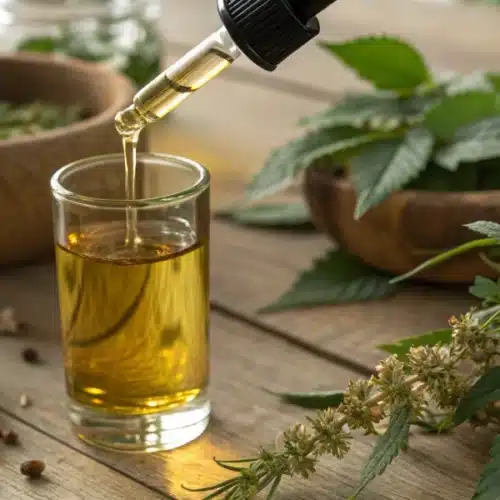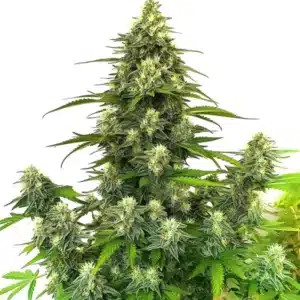Lighting is essential for indoor cultivation because the lights are what replace the sun. For this reason, the light spectrum is essential if you want good growth and excellent flowering of plants. The lights imitate the spectrum of the sun, therefore, they must emit the spectrum that is most similar to sunlight. If you do not use the correct lighting in your indoor cultivation, you will not achieve the results that you expect and want.
It is always good to remember that autoflowering strains should receive 20 hours of light and 4 hours of darkness during their growth and 18 hours of light plus 6 hours of darkness during flowering. Although, some breeders prefer to keep the hours of light constant in order to ensure a constant yield and to take advantage of the fact that they are not dependent on lighting as their name implies.
Light spectrum
The light spectrum is the various shades of color (also known as wavelengths) that lights initially release. The calculation of illumination is done in nanometers and with the use of a nanometer to represent a band of light (a band of light is a segment in the color palette). This instrument is required because people can only see part of the spectrum from red to violet.
For its part, the sun is a full-spectrum light source. In other words, its wavelength contains all the colors that are needed in a cannabis crop and that is why plants grown outdoors during the summer season with the sun at its maximum power develop in a great way and produce hard buds that are fat and heavy as a rock.
Now, we must differentiate between growth and flowering because in both periods the plants may need a different light spectrum. In the growth stage, wild autoflowering plants use the blue hue of the sun to ensure the growth of their leaves and structure. When we grow autoflowering varieties indoors, we must ensure that they have as many leaves as possible. The autoflowering cannabis plant will absorb as much light as possible for the development of its leaves, branches, and main stem which can ensure a great flowering and subsequent harvest.
In the case of flowering autoflowering plants, wild varieties use the sun’s red spectrum to promote bud formation. For the same reason, if you want your autoflowering plants to produce fat and heavy buds, you should consider using an orange spectrum light such as sodium bulbs. This also maximizes the amount of photosynthesis, promoting the production of buds. Despite these tips, we recommend using full spectrum lights as they are more efficient in terms of cost and tone. It emits different wavelengths throughout the cultivation process.
At this point, we are going to show you the light spectrum that you can find in the light and we recommend that if you want full spectrum lighting to have healthy plants, it is best to use LED lighting. These lighting systems can be more expensive than others, but that is compensated for as they consume much less electricity than traditional HPS lighting.
UV Light: Improves the trichomes and also enhances the plant in the development of its structure.
Bluish Light: Helps plants with the green pigment or chlorophyll and with the size of the leaves.
Deep Blue Light: Helps with the development of leaves and branches.
Green Light: Not used much.
Yellow: It is fundamental for the nutrition of the plant as it helps with the retention of micronutrients.
Red Light: It contributes during flowering because it helps in photosynthesis and in the production of buds.
Deep Red Light: Contributes to the improvement of the buds and subsequently, the crops.

Promos & Deals
Light distance from plants
In the previous point, we talked about the light spectrum and we explained that it is best to use an LED lighting system with a white light spectrum because it includes the entire range of colors that the plant needs. However, an important issue is knowing what distance the lighting systems should be placed from the plants. This is because in many cases gardeners, especially novices, tend to put the lights very far away, causing the plants to spike or very close, preventing the optimal growth of the plant. This causes the plant to be stressed, have coloration problems in its leaves, or stagnant growth.
A key factor to consider is the “Seedling Light Distance.” A standard measurement for the distance between seedlings and indoor LED grow lights should generally be between 24 and 36 inches above the top of the cannabis plant. This certainly depends on the power (wattage) of the lighting system you use. Position your LED grow lights at the farthest distance from the seedlings (~36″) to keep heat and light intensity levels low and prevent seedlings from drying out. As the plant grows, you can turn the light down after the second or third week.
In the vegetative stage, the LED lights should be 12-24 inches away from the top of the plant. They require more light as growth progresses, so you can carefully move the light a little closer. As plants move into the flowering stage, they need less intense light. So, the light should be located between 18 and 24 inches from the top of the plant. Remember that this is when the plants increase in height and in some cases, thicken in size. It all depends on the power of the lights you use. If the power is high, you do not need to change the distance between the plants and the lighting system.
When the plants are in bloom, the LED grow lights should be placed between 16 and 36 inches from the plant canopy. Bringing the grow light closer will increase the intensity of the light which can maximize photosynthesis. However, if the grow lights are too close to the plants, they can cause more extensive and sprawling growth or even damage the plant.
Automatic cannabis seeds vs Fast Version seeds
At this point, we want to stop briefly to tell you that Fast Version or Fast Blooming strains require the same light as autoflowering or feminized genetics. Therefore, you should pay attention to the details in your lighting system and also to the tips we are going to give you in this guide regarding this type of cannabis seed.
Fast version strains are the result of the crossing of an elite feminized photo-dependent variety and an autoflowering strain. However, unlike the latter, the fast varieties do depend on the number of hours of light received during growth. They must receive 18 hours of light and another 6 hours of darkness. In flowering, it is important to change the cycle to 12 hours of light and 12 hours of darkness.
The advantage of the Fast Version and Fast Blooming varieties, compared to the Feminized strains, is their shorter flowering time which is reduced by an average of two weeks. Fast Version cannabis plants are ready to be harvested in a flowering of 7-8 weeks. The advantage of the autoflowering varieties is that the harvests are larger. Monster plants can be obtained and in a time similar to an automatic strain, making them irresistible to any gardener.
If you want to obtain more powerful plants with a stronger development and higher production, you just have to extend the hours of growth lighting 1 or 2 weeks more than normal to produce a robust Fast Version plant with incredible bud production. You already have a general idea about the Fast Version strain and now we are going to look at the best autoflowering varieties.
Best Autoflower varieties
We couldn’t miss the opportunity to share the best autoflowering strains for indoor or outdoor cultivation in 2022. We made this selection thinking of breeders who want heavy yields, high THC levels, or rich flavors. We also do not leave out the lovers of mostly indica or sativa varieties, so that you can grow autoflower marijuana plants regardless of the light cycle.

San Fernando Valley Auto
San Fernando Valley Auto is mostly indica and very fast with a life cycle from seed to harvest of 8-9 weeks thanks to its parents, SFV OG x Afghani x Ruderalis. If we talk about potency, the THC that it contains ranges from 14%-20% with plants that reach up to 1.50m. For this reason, it is compact and discreet and ideal for cultivation in small spaces or in outdoor crops that need to go unnoticed.
On the other hand, you will feel a breath of fresh air in each puff thanks to the pine flavors with high citrus notes that smell great to the nose. In addition, outdoor harvests are between 100-150 gr/plant, making it perfect for cultivation in pots of up to 2.5 gallon or 10L. For indoor growers, we recommend doing a SOG type cultivation to maximize harvest yields and reach 250-300 gr/m2 in each crop.
Devil XXL Feminized strain
Devil XXL brings together two authentic cannabis classics in their autoflowering versions, Big Devil #2 and Auto Jack Herer, who give the XXL size to this strain. You can grow this variety successfully outdoors, indoors, or in a greenhouse because it is easy to grow.
It is important to emphasize that because it is an autoflowering variety of XXL size, it tends to have a slightly larger size, above the average of other automatic strains. Therefore, certain cultivation techniques such as LST training can be applied to achieve more uniform plants by stretching their lateral branches and more forceful central buds because of better light penetration. Using cultivation techniques, you obtain the maximum yield in the crop with 450-500 gr/m2 indoors and about 60-200 gr/plant outdoors of buds that give off spicy and citrus flavors.
Blueberry x Lemon Autoflower strain
This variety that comes from a cross between Blueberry x Lemon Haze Auto is mostly sativa with flavors that evoke notes of hashish, fruit, and citrus. Because this strain is mostly sativa, it is best to cultivate it outdoors during the summer season so that it has the greatest number of daylight hours and takes advantage of the warmer temperatures.
If you grow Blueberry x Lemon Haze Auto indoors, make sure it has the best lighting possible so that it reaches its optimum development and bud production. This variety is highly adaptable to LED lighting and also to HPS. 400w or 600w sodium bulbs give it the possibility of reaching its maximum harvest of 250gr/m2. The large size of this autoflowering plant when grown indoors with hydroponics systems stands out, producing long arms and a central tail that is covered with sticky flowers that shine thanks to the large volume of resin they produce and the high levels of THC ranging from 16% to 22%.
Critical x AK47 Autoflower strain
First, it is good to point out that Critical x Ak47 Auto is a hybrid strain. For this reason, you can find some large specimens due to its 50% sativa side that generates medium-sized plants of up to 1.50m with medium-distance internodes and round, fat flowers and 16%-20% THC levels.
Critical x AK47 Auto is perfect for doing some type of LST training or for mass cultivation in small 7L or 2 gallon pots which can harvest 450-550 gr/m2 of buds indoors. The cycle of this variety is short, only 9-10 weeks, and produces buds with flavors of vanilla, earthy, sweet, and tropical.
TRIPLE XL Autoflower strain
This dominant indica called Triple XL Auto is a high quality strain that is perfect for growing with the SOG technique as you can get indoor yields of 800-1000 gr/m2 in a 1m x 1m space with high quality lighting and power. We recommend covering each cultivation space with 400w or 600w sodium lighting or state-of-the-art LED lights that have the widest possible light spectrum. If you grow Triple XL Auto outdoors, we recommend that you do it at the end of spring so that in summer, you can have the greatest number of light hours of the season for the production of buds, ranging from 20-200 gr/plant.
In this type of plant, organic nutrients are good because the plants have greater growth and flowering. The XL size of Triple XL Auto comes from its parents, Northern Light #5 x Big Bud x Green Crack. They also give it a productive character with abundant harvests and sticky, heavy buds.
Now, you have everything you need to make a great crop of autoflowering strains because you already know which are the best indoor strains, how to use lights, and the basic fundamentals for cultivation. Remember that the best lighting system for your marijuana cultivation will be the one that best suits your budget and also the one that is appropriate according to your cultivation area because each space has its own requirements for producing the best weed that you can imagine.
















